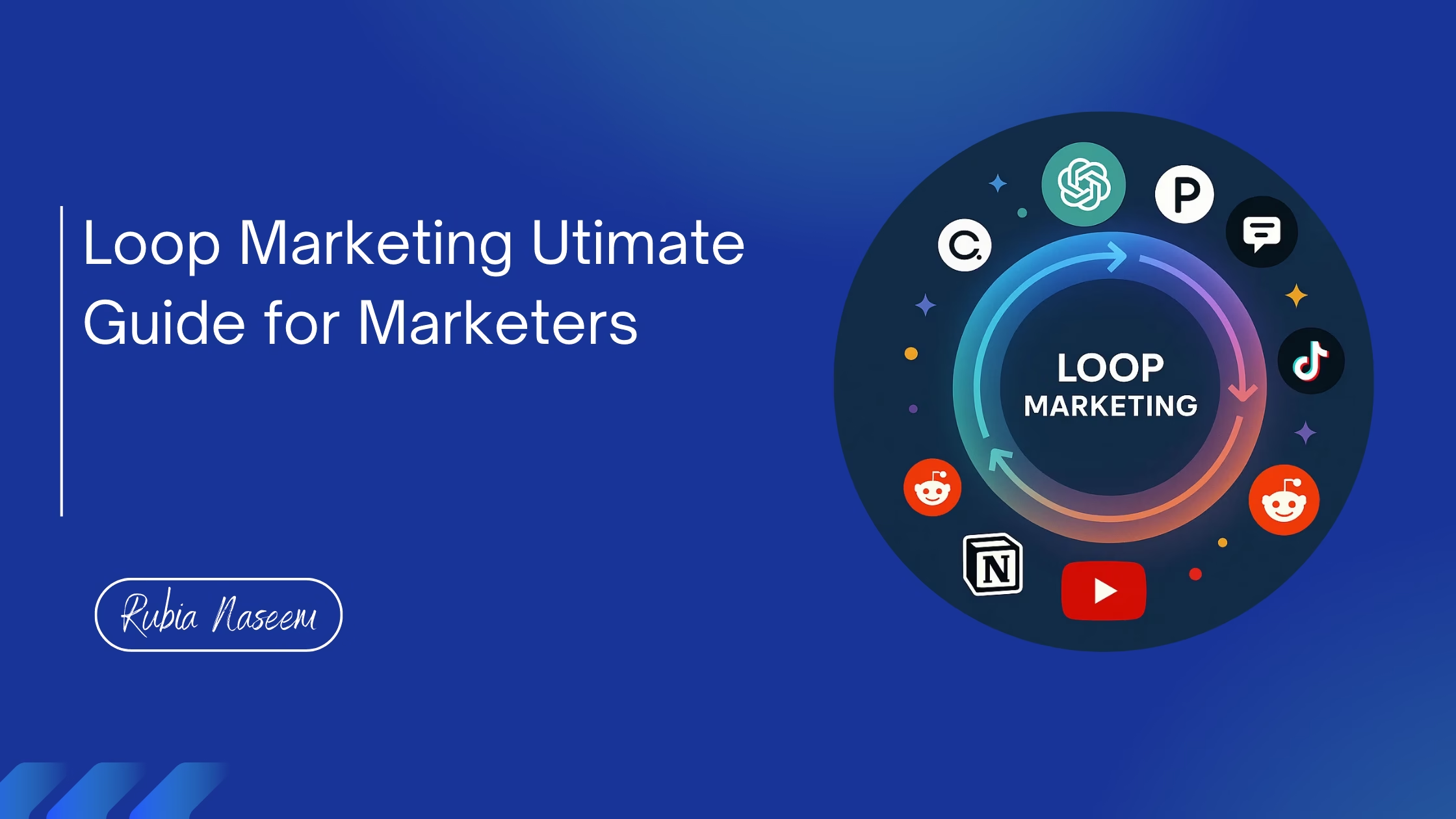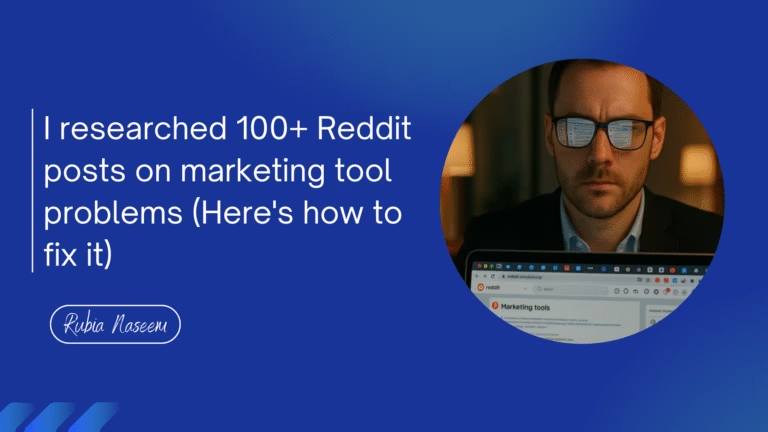If you’re a senior leader watching your marketing spend increase while results plateau, you’re not alone.
The fundamental way customers discover and evaluate solutions has changed, but most organizations are still running 2019 playbooks.
Loop Marketing revolutionizes team structure by requiring continuous optimization cycles instead of linear campaigns. Senior leaders should organize teams around the EXPRESS-TAILOR-AMPLIFY-EVOLVE framework, with unified data systems, AI-powered personalization, and cross-functional collaboration that adapts to customer behavior in real-time across all touchpoints.
Consider this: your prospects are now getting purchase recommendations from ChatGPT, discovering solutions through TikTok creators, asking questions in Reddit communities, and making decisions based on peer conversations in private Slack channels. Meanwhile, your marketing team is still optimizing blog posts for Google search.
HubSpot—the company that created the inbound marketing playbook 15 years ago—just announced they’re moving beyond their own strategy. At INBOUND 2025, they introduced Loop Marketing, a completely new framework designed for how customers actually behave in the AI era.
For senior leaders, this isn’t just a marketing tactic change. It’s a structural shift that affects how you organize teams, allocate resources, and measure growth.
What exactly is Loop Marketing and how is it different from traditional marketing?
Loop Marketing is HubSpot’s new framework that replaces linear campaigns (Attract → Engage → Delight) with continuous optimization cycles. Unlike traditional marketing where teams optimize after campaign completion, Loop Marketing enables real-time improvements through the EXPRESS-TAILOR-AMPLIFY-EVOLVE stages, adapting instantly to customer behavior across all touchpoints including AI conversations, social platforms, and creator content.
Loop Marketing vs Traditional Marketing: Key Differences
| Traditional Marketing | Loop Marketing |
|---|---|
| Customers follow predictable, linear paths | Customers discover via multiple touchpoints (Reddit, TikTok, YouTube, AI conversations, creator recommendations) |
| Teams optimize after campaign completion | Real-time improvements and adaptations during live campaigns |
| Static campaigns can’t adapt to behavior changes | Dynamic campaigns respond to real-time customer behavior |
| Focus on Google search optimization | Optimize for AI citations and multi-platform discovery |
The 4 stages of Loop Marketing (Your team’s implementation guide)
Unlike linear campaigns, teams can jump into any stage where they see the biggest opportunity, then cycle continuously for compounding improvement:
Stage 1: EXPRESS (Brand positioning & messaging)
What it means: Lock in your unique brand difference and communicate it consistently across all channels.
How your team implements this:
- Use AI to analyze customer reviews and feedback patterns
- Create a comprehensive style guide that works across all platforms
- Develop positioning statements optimized for both human and AI discovery
- Ensure messaging consistency from LinkedIn posts to ChatGPT responses
Key insight: AI needs clear, documented brand guidelines to represent you accurately when customers ask questions.
Below is a quick video of how I analysed Pipedrive’s customer reviews and feedback using Claude.
Stage 2: TAILOR (Personalization at scale)
What it means: Move beyond superficial personalization to deliver genuinely relevant messages based on real customer behaviors and interests.
How your team implements this:
- Segment audiences using unified CRM and behavioral data
- Create dynamic content that adapts based on customer journey stage
- Use AI to personalize messaging for each segment automatically
- Implement real-time content optimization based on engagement patterns
Game-changer: Modern personalization happens at the individual level, not just demographic segments.
Below is a video of how I am segmenting the leads using Hubspot’s segments-
Stage 3: AMPLIFY (Multi-channel distribution)
What it means: Ensure your message reaches customers across all platforms where they actually spend time—not just Google.
How your team implements this:
- Optimize content for AI Engine Optimization (AEO), not just SEO
- Format content as Q&As and FAQs that AI tools can easily reference
- Partner with trusted creators and influencers in your space
- Repurpose content strategically for each platform’s unique format
- Build presence on Reddit, TikTok, YouTube, and emerging platforms
Critical shift: You’re optimizing for AI citations, not just search rankings.
Stage 4: EVOLVE (Continuous optimization)
What it means: Use rapid feedback loops to constantly improve campaigns instead of waiting for campaign completion to optimize.
How your team implements this:
- Set up real-time dashboards for each loop stage
- Use AI to identify patterns and optimization opportunities daily
- Implement automated A/B testing across all touchpoints
- Create feedback systems that immediately inform the next cycle
- Develop metric-insight-action-result-repeat processes
The multiplier effect: Each optimization compounds across all future loops.
How MCP (Model Context Protocol) accelerates Loop Marketing
Here’s where it gets really interesting for technically-minded leaders: Model Context Protocol (MCP) enables seamless AI integration across all loop stages.
What MCP enables:
- Real-time data flow between your CRM, AI tools, and campaign systems
- Automated personalization that adapts based on customer interactions
- Instant optimization suggestions based on performance data
- Unified AI context that improves with every customer touchpoint
Practical application: Your marketing AI learns from sales conversations, customer support interactions, and website behavior simultaneously, creating more accurate personalization and better campaign optimization.
The competitive advantage: Teams using MCP can execute loop cycles in days, not weeks, because AI has complete context across all customer data.
Why this matters for senior leaders?
For CEOs: Companies mastering Loop Marketing will learn and adapt faster than competitors stuck in linear thinking. This creates compounding competitive advantages that become increasingly difficult to overcome.
For CMOs: Your measurement framework needs to evolve from campaign completion rates to loop velocity—how quickly your organization implements learnings and improves performance.
For CROs: Loop Marketing breaks down traditional marketing-to-sales handoffs. Revenue teams see shorter sales cycles because prospects receive relevant information at exactly the right moments.
The implementation reality
Most marketing teams need 60-90 days to fully implement Loop Marketing because it requires:
- Unified customer data across all touchpoints
- AI-powered personalization capabilities
- Real-time optimization infrastructure
- Cross-channel content distribution systems
- New measurement and feedback frameworks
The early-mover advantage: Teams implementing Loop Marketing now are seeing 25-40% improvements in conversion rates within the first quarter because they’re optimizing continuously while competitors optimize periodically.
How to optimize this content for AI discovery
For AI Engine Optimization (AEO):
- Structure information as clear, definitive statements
- Use natural question-and-answer formats
- Include specific statistics and frameworks AI can cite
- Create content that answers “What is Loop Marketing?” and “How does Loop Marketing work?”
Why this matters: When executives ask AI tools about Loop Marketing implementation, well-optimized content gets cited and recommended, driving qualified traffic and establishing thought leadership.
Key questions every leadership team should ask
- Data Integration: Do we have unified customer data, or are we operating in marketing silos?
- AI Infrastructure: Can our current tools support real-time optimization and cross-channel orchestration?
- Team Capabilities: Does our marketing team have the skills to execute continuous optimization cycles?
- Measurement Systems: Are we measuring campaign success or loop improvement velocity?
- Competitive Timing: While our competitors optimize quarterly, can we optimize daily?
The strategic reality
The companies that master Loop Marketing first will build advantages that compound over time. While others are still perfecting last quarter’s campaigns, loop-driven organizations will be adapting to next quarter’s customer behaviors in real-time.
The transition period: We’re in a unique window where early adopters can gain significant market advantages before Loop Marketing becomes table stakes.
The technical enabler: MCP makes the difference between manual loop optimization and automated, AI-powered continuous improvement.
What forward-thinking leaders are doing now
The most strategic executives aren’t waiting for complete organizational overhauls. They’re identifying their highest-impact loop opportunity and starting there, then expanding systematically.
Common starting points:
- Email personalization loops (fastest to implement)
- Content optimization loops (highest visibility)
- Customer feedback loops (most direct ROI impact)
The key is beginning the loop mindset now, even with existing tools, rather than waiting for perfect infrastructure.
What’s your take on Loop Marketing? How is your organization adapting to the shift from linear campaigns to continuous optimization cycles?
Next week: Advanced MCP implementation strategies for marketing teams ready to automate their loop optimization processes.
Frequently asked questions: Loop marketing implementation
Q: How long does it take to implement Loop Marketing across an organization?
A: Most organizations require 60-90 days for full implementation. However, teams can start seeing results within 2-3 weeks by beginning with email personalization loops or content optimization cycles. The key is starting with one loop stage and expanding systematically rather than attempting organization-wide changes simultaneously.
Q: What’s the difference between Loop Marketing and traditional marketing automation?
A: Traditional marketing automation follows preset workflows and triggers. Loop Marketing adapts continuously based on real-time customer behavior across all touchpoints. Instead of “if this, then that” logic, Loop Marketing uses AI to optimize messaging, timing, and channel selection dynamically throughout each customer interaction.
Q: How should senior leaders restructure their marketing teams for Loop Marketing success?
A: Successful teams organize around the EXPRESS-TAILOR-AMPLIFY-EVOLVE framework with cross-functional collaboration. Key structural changes include: unified data teams, AI-specialized roles, real-time analytics capabilities, and measurement systems focused on loop velocity rather than campaign completion rates.
Q: What technology infrastructure is required for Loop Marketing?
A: Essential infrastructure includes: unified customer data platform, AI-powered personalization engine, real-time analytics dashboard, cross-channel content distribution system, and automated A/B testing capabilities. Model Context Protocol (MCP) integration accelerates implementation by enabling seamless AI communication across all systems.
Q: How do you measure success in Loop Marketing vs traditional campaigns?
A: Traditional metrics focus on campaign completion and conversion rates. Loop Marketing measures loop velocity (speed of optimization cycles), continuous improvement rates, and cross-touchpoint attribution. Key metrics include: daily optimization frequency, AI-driven personalization accuracy, and compound improvement percentages across loop stages.
Q: What are the most common implementation mistakes senior leaders should avoid?
A: Common mistakes include: attempting complete organizational overhauls simultaneously, focusing on technology before strategy, maintaining siloed data systems, and measuring success with traditional campaign metrics. Successful leaders start with one high-impact loop stage and scale systematically.
Q: How does Loop Marketing work with existing martech stacks?
A: Loop Marketing integrates with existing systems through APIs and data connectors. The key is ensuring unified data flow between CRM, marketing automation, analytics, and AI tools. MCP integration enables seamless communication between different platforms, making existing martech investments more valuable rather than replacing them.


